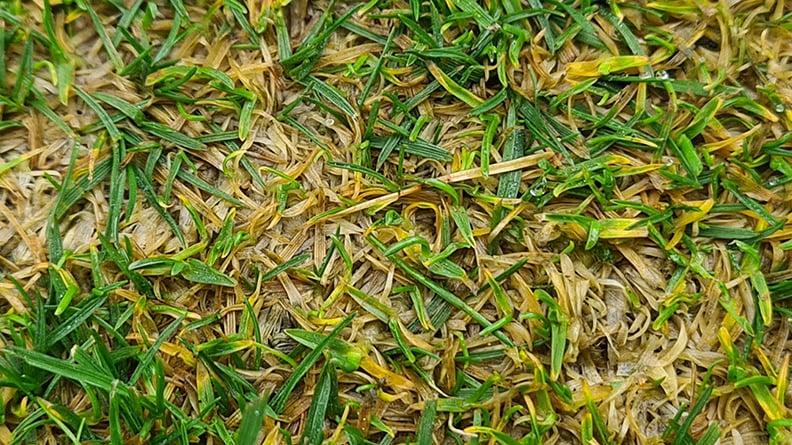Research-based anthracnose management
A research-based approach to tackling anthracnose in fine turf, shaped by scientific evidence and real-world experience. Focused on prevention, resilience, and smarter decision-making.
On this page:
Anthracnose (Colletotrichum cereale) remains a significant challenge across UK and Irish fine turf surfaces, particularly in Poa annua-dominant greens under summer stress.
The disease, predominantly seen as basal rot anthracnose in this region, exploits periods of low plant vigour and environmental stress, undermining playing surface quality and turf resilience.
This article outlines a robust, research-supported strategy for anthracnose management, drawing on both scientific literature and practical insights. The goal is to equip turf managers with a reliable, integrated approach to prevention and suppression.

Anthracnose (Colletotrichum cereale)
Understanding disease drivers
Basal rot anthracnose thrives under:
- Low nitrogen fertility
- Soil compaction and thatch accumulation
- High temperatures and drought stress
- Low mowing heights
- Prolonged leaf wetness
Importantly, many of these conditions are either intentionally created or unavoidable in high-performance turf management. Balancing agronomic intent with disease pressure is therefore essential.
Nitrogen management: consistency and form matter
Numerous studies, including foundational work by Hempfling et al. (2017), have shown that consistent, moderate nitrogen input is the cornerstone of anthracnose suppression. Inadequate nitrogen compromises turf health and defences, opening the door to infection.
Beyond rate, the form of nitrogen significantly influences nutrient uptake dynamics:
- Nitrate-based nitrogen supports balanced cation absorption, particularly of potassium and calcium.
- Ammonium-based nitrogen can compete for uptake pathways, potentially inducing cation deficiencies during high-stress periods.
Best practice recommendations:
- Apply 2–3 kg N/ha/week during peak stress periods (late June to early September)
- Prefer nitrate-dominant fertilisers in summer (e.g potassium nitrate such as the Sportsmaster WSF High N 35-0-14 formulation or the Greenmaster Liquid Cal-Mag 15-0-0 which contains calcium and magnesium nitrate)
- Avoid ammonium sulphate during heat stress unless specifically correcting pH

Anthracnose (Colletotrichum cereale)
Potassium and calcium: supporting structural defence
While not directly curative, potassium and calcium play supportive roles in maintaining cell wall integrity and osmotic balance. Deficiencies in either can exacerbate susceptibility, especially when paired with heat and moisture stress.
Balanced nutrition programmes, guided by regular tissue testing, ensure sufficiency without excess. The goal is not to “boost” these nutrients in isolation, but to support overall plant health under pressure.
Surface practices: overseeding, topdressing, and cultural inputs
Concerns about mechanical operations exacerbating anthracnose are common, yet research and field experience indicate that moderate disturbance is acceptable, provided the turf is not already heavily stressed.
Practical Guidance:
- Overseed proactively in early decline phases to improve species composition
- Use light sand topdressing to reduce surface moisture retention and smooth play
- Avoid aggressive verticutting during peak disease windows
pH management and species transition
An acidic soil pH is often used strategically to favour Agrostis over Poa annua. However, lower pH can also create conditions more favourable to anthracnose.
Management Tip:
- Where pH is <5.5, monitor closely for anthracnose risk
- Consider the neutralising effect of spring sand dressings (typically pH >7)
- Communicate pH strategy clearly to clients or committees to align disease expectations with species transition goals
Fungicide strategy: timely, targeted, and rotational
Fungicides remain essential in an integrated programme, especially when disease pressure coincides with low cutting heights and environmental stress. Once conditions conducive to anthracnose occur, or the Syngenta Turf Advisor app, indicates high risks of disease a preventative application of Ascernity or Heritage should be applied. However, misuse or over-reliance risks resistance development.
Key Principles:
- Apply preventively ahead of forecasted high-risk conditions
- Rotate FRAC codes to maintain efficacy (e.g. Group 11 QoI, Group 3 DMI)
- Follow label guidance and local stewardship schemes
Integrated management: the five pillars
Successful anthracnose management is cumulative. Relying on any one method invites risk. Based on the latest research and best practice, an effective programme includes:
- Consistent, nitrate-based nitrogen feeding during high-risk periods
- Balanced potassium and calcium nutrition, verified by tissue analysis
- Surface stress reduction through adjusted mowing, irrigation, and traffic management
- Strategic pH and species transition planning
- Preventive, rotational fungicide use guided by risk forecasting
Final thoughts
Anthracnose is a stress-exploiting disease. In striving for elite turf quality, managers often create the very conditions that favour its development.
The solution lies in an informed, balanced approach. This supports plant health, respects the biology of the disease, and integrates multiple strategies for long-term resilience.
With the right cultural, nutritional, and chemical tools applied at the right times, anthracnose can be effectively managed, ensuring surface quality and professional confidence remain uncompromised through the toughest summer months.






